How to Puree Red Bell Pepper and Sweet Potato for Baby
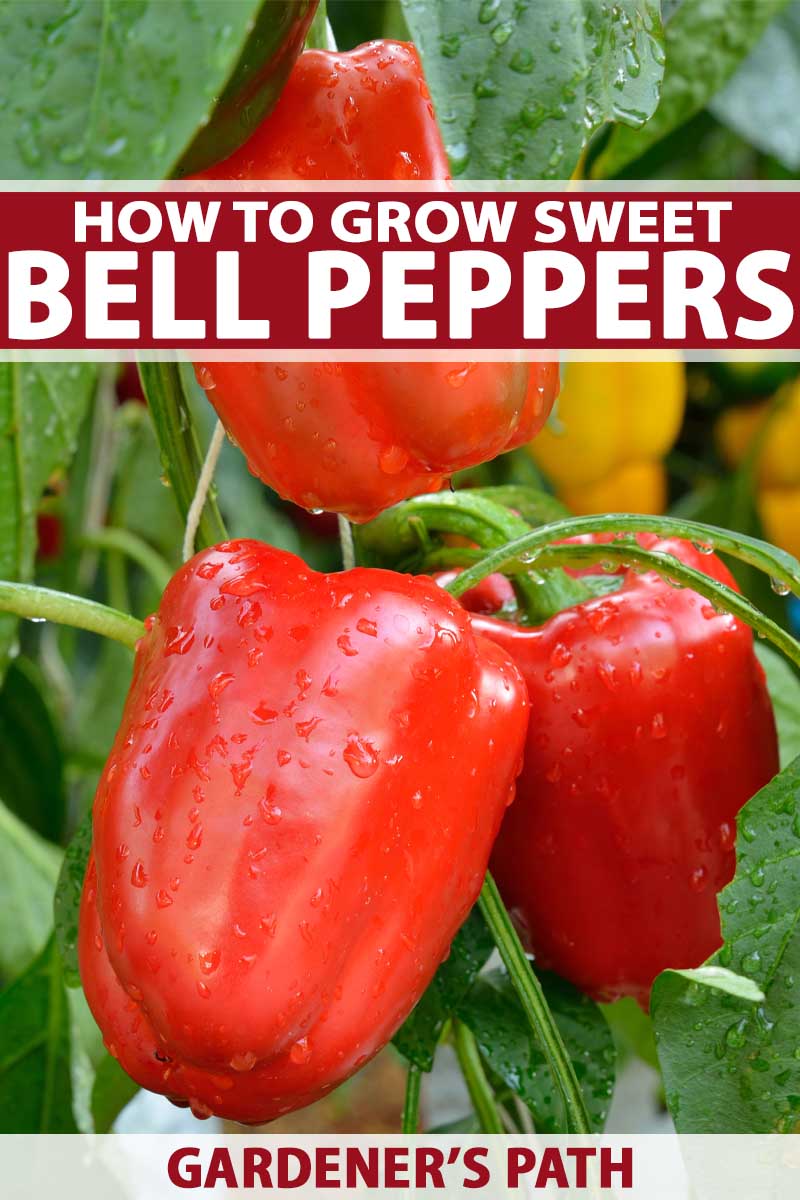
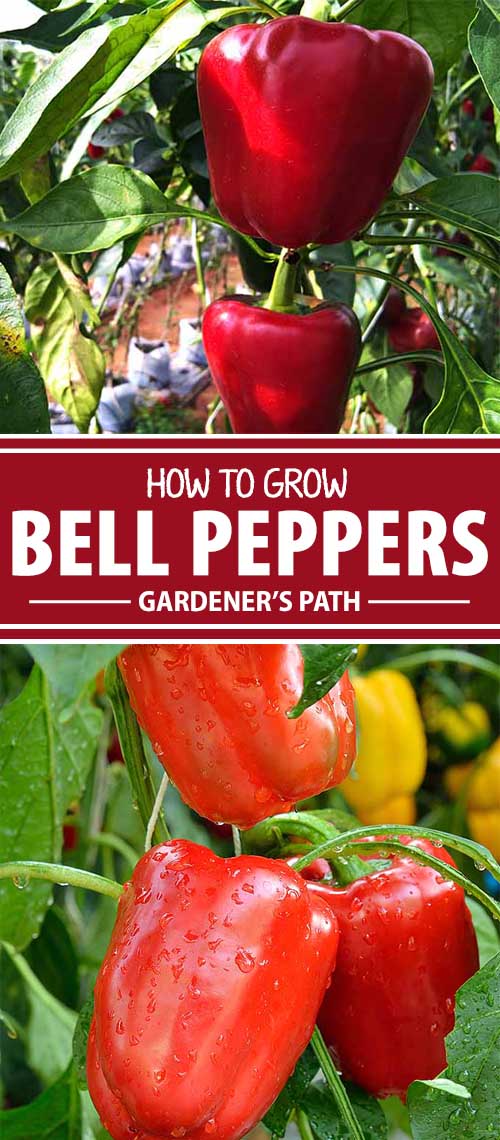
There are few plants in the garden more satisfying to grow than bell peppers, i of the many types of peppers to autumn under the scientific proper name Capsicum annuum.
Rich green leaves, a compact grade, and brightly colored fruit make them a contender for even the nearly formal gardens.
I did say fruit. So many of the plants nosotros normally refer to as vegetables are really fruit, including peppers, for the elementary fact that they are seed bearing.

We link to vendors to assistance y'all notice relevant products. If you buy from one of our links, we may earn a commission .
Peppers are believed to have originated in Southward America and Mexico.
From omelets to tacos, to pasta dishes and salads, sweet bells provide a tasty crunch to and so many popular meals without the spice. Simply cipher beats the crunch of a freshly picked fruit.
It may seem intimidating for the beginner gardener just, equally long as you know a few key pieces of information before getting started, bong peppers are fairly piece of cake to grow – every bit long equally the conditions plays along, that is.

This article will walk you through it all, from starting seeds to transplanting seedlings to institute care and maintenance, and so that you can grow and savor these beauties in your own garden.
What Y'all'll Learn
- Beginning Early
- What to Found and Where to Purchase
- Transplanting
- Growing Salubrious Plants
- Managing Pests and Diseases
- Harvesting
- A Few Recipe Ideas
- Worth the Endeavour
Start Early
Bell peppers are a perennial in tropical areas. Only in colder climates, they are grown as annuals and they actually take no tolerance for cold conditions.
They require a adequately long growing season, oftentimes upwards to 90 or even 100 days, then the shorter your summertime, the sooner yous demand to start seeds indoors.
It is possible to save seeds from organic store bought bell peppers. Collect seeds from cherry peppers, since they are more mature then green ones, and prepare them out to dry for a few days. Then sow them or store them in a newspaper envelope and place them in a dry location for safekeeping.
Definitely consider buying seeds as well, since one of the benefits to growing your own bell peppers is choosing from a number of otherwise unavailable varieties.
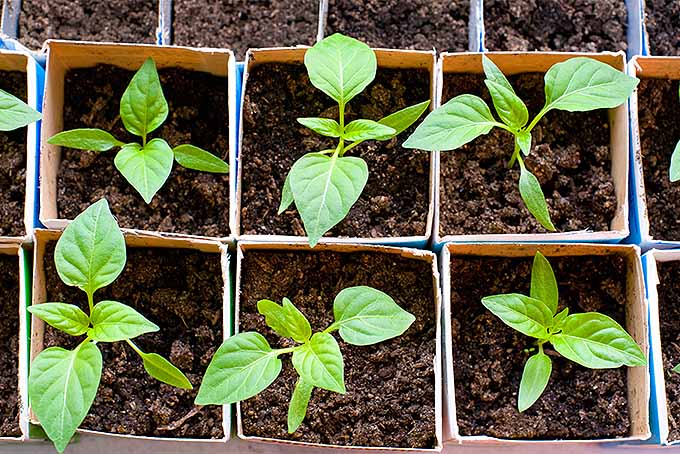
The rule of thumb is to first seeds vi to eight weeks before the last average frost date in leap. However, if you go on plants healthy and thriving, you can sow them even earlier.
Start seeds using a seed starting mix and place them in a warm, sunny spot. Covering flats or cell packs with plastic can assistance speed formation rates.
Providing a consistent source of rut, like with a seedling heat mat, will also help since soil needs to be around 80°F for seeds to germinate. If soil is warm enough, formation should occur within ten days.
Once seeds germinate and grow two to iii true leaves, you'll want to pot them in larger containers filled with damp potting soil to reduce settling. Add together organic fertilizer co-ordinate to label recommendations every bit well, to encourage strong growth.
H2o newly potted plants well and keep them consistently moist.
What to Plant and Where to Buy
At that place are many different types of sweetness bell peppers available on the market today, and they can be grown from seeds or started equally seedlings. Let'southward have a expect at a few favorites.
Canary Bell
Slow and steady wins the race, when it comes to the xanthous Canary bell. These take 100 days to reach maturity, only the long wait will exist worth it when yous go to enjoy these prolific iii 1/two-by-4-inch sunshine yellow fruits.
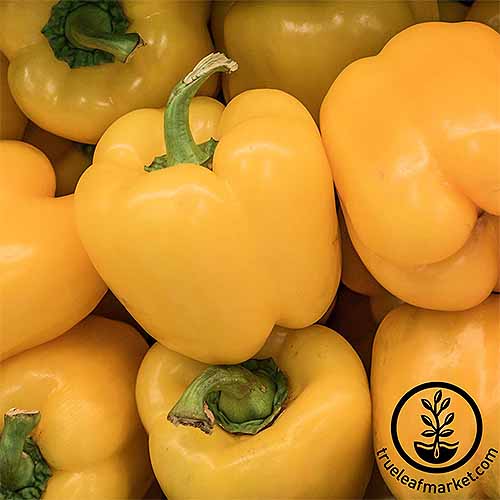
'Canary' Bong Seeds
Tobacco Mosaic Virus resistant seeds are available in 1/4- or one-ounce packages from True Leaf Market place.
Big Reddish
Big Red takes near 75 days to harvest, turning from green to blood-red as it ripens. This sweet pepper has very thick flesh with a mixture of iii- and 4-lobed blocky fruits.

'Large Red' Seeds
A veggie patch favorite, seeds are available in a diversity of packet sizes from True Leafage Market.
Coral Bong
Vibrant orangish Coral bell peppers are a welcome addition to the garden, growing vigorously and producing iv-lobed fruit that reach about 4-by-three 1/2-inches at maturity.

'Coral' Bong Seeds
Seeds are available from True Leaf in 1/4- or 1-ounce packages. Expect 78-88 days to harvest.
California Wonder
California Wonder 300 TMR is delicious when picked green, or can exist left on the plant to ripen to a sweeter red pepper.
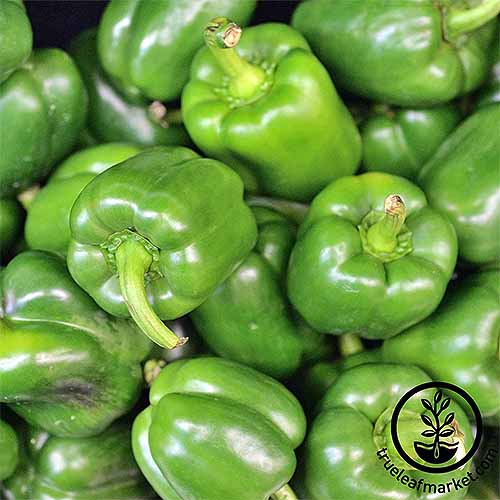
'California Wonder' 300 TMR, available from True Leaf Market place
This 4-lobed fruit makes a delicious stuffed pepper, on the larger side at effectually iv-by-4 ½-inches max. The "TMR" in the proper name stands for Tobacco Mosaic Virus Resistant, and y'all can look about 75 days to maturity.
Purple Beauty
Majestic Dazzler is a hitting heirloom pepper with a deep majestic color, thick-walled flesh, and 4-past-3-inch fruit.
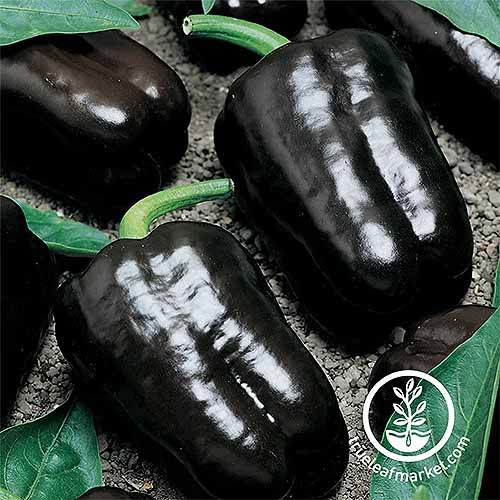
'Purple Beauty' Seeds
These will take about seventy days to reach maturity. Packages of thousand seeds are available from True Leaf Market. Alive plants are also bachelor via Amazon.
Chocolate Beauty
For something a little unlike, the Chocolate Beauty offers a luscious, deep brown color with super sugariness flesh. It grows quickly, with about 67-70 days to maturity, and is Tobacco Mosaic Virus resistant.

'Chocolate Beauty' Seeds
Seeds are available from True Leafage. And live plants are available via Amazon.
Transplanting
Although you lot may be tempted to practice it sooner, wait to transplant peppers to the garden until a couple of weeks past the concluding frost appointment. Make sure to harden them off first though, or your plants may not make it at all.
Hardening off simply refers to the process of getting plants acclimated to a new environment. Plants that have been grown indoors for months will likely become severely stressed or fifty-fifty dice if placed straight in the garden, and we desire to avert this.
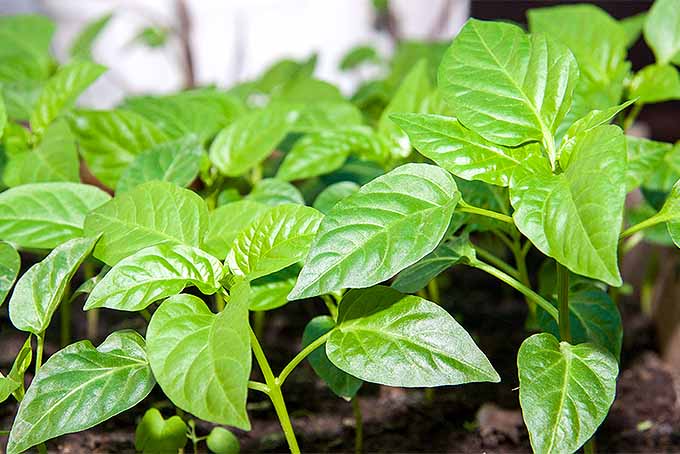
Instead, slowly introduce plants to outdoor conditions. Over the grade of several days, set them outside for longer periods of time. Start in the morning and bring them in later and later each twenty-four hour period until you are confident they have adjusted.
Before transplanting, brand certain the soil temperature is warm enough, usually around 65°F. Transplanting can stress a found and cause blossom drop, and then yous'll want to remove any flowers that form earlier giving them a permanent home.
In the garden, leave at least 18 inches between plants, mayhap more, depending on the variety you lot're growing.
Water newly planted bell peppers really well and add together an inch or two of organic mulch. Their roots are shallow and mulch volition help to maintain moisture and protect roots from wet related stress.
Growing Healthy Plants
Bell peppers generally demand warm soil and warm temperatures to thrive.
To encourage faster growth in cooler areas, consider laying black plastic over the soil. Just be careful not to let the soil get so hot that beneficial soil bacteria are killed. Remember that the target temperature is only 65°F, and don't overdo information technology.
Full sunday and loamy, rich, well draining soil with a pH near neutral is platonic for planting.
For improved fruit production, keep plants evenly moist throughout the season. Too moisture or also dry out, and you'll probable notice a pass up in the plant'due south overall wellness or fruit evolution.
It's peculiarly of import to keep plants consistently watered when they are in bloom and producing fruit. Between 1 and ane i/2 inches of water each calendar week should be sufficient.
Unfortunately, even if y'all do everything else right, bell peppers won't produce much fruit if temperatures aren't ideal, typically betwixt 70 and 90°F.

They will be sloth-like in growth if nighttime temperatures fall below 55°F. And if temperatures are too hot, they will likely start to drop their blossoms before ever having a take chances to set fruit. This is why they're considered a bit more temperamental to abound than another veggie patch favorites similar spinach or radishes.
Shallow roots and heavy fruits make bong peppers more probable to topple over, then consider staking them one time flowers begin to grade.
While fertilizing is helpful, be cautious non to over fertilize, specially with nitrogen. This is known to crusade leafy green growth, simply it will actually stunt flower and fruit product.
Bell peppers are in the Solanaceae family, along with tomatoes, eggplant, and potatoes. This means they share many of the aforementioned disease and pest bug, equally well equally nutritional needs. For this reason, yous'll want to avoid rotating these crops with each other in the garden.
Managing Pests and Diseases
Bong pepper plants are susceptible to overwatering or poor draining soils. So be aware of root rot and phytophthora bane, a fungal disease that causes permanent wilt.
Some other outcome linked to moisture stress is blossom finish rot, which shows up as a nighttime, sunken area on the fruit. Information technology'due south adequately common and is a upshot of calcium deficiency.
However, but considering plants are calcium scarce, this doesn't necessarily hateful the soil is. Rather, the outcome could just be that calcium present in the soil is tied up for one reason or another.
For instance, if soil pH is too low, calcium uptake can be afflicted. Likewise, inconsistent moisture levels tin can negatively impact calcium availability.
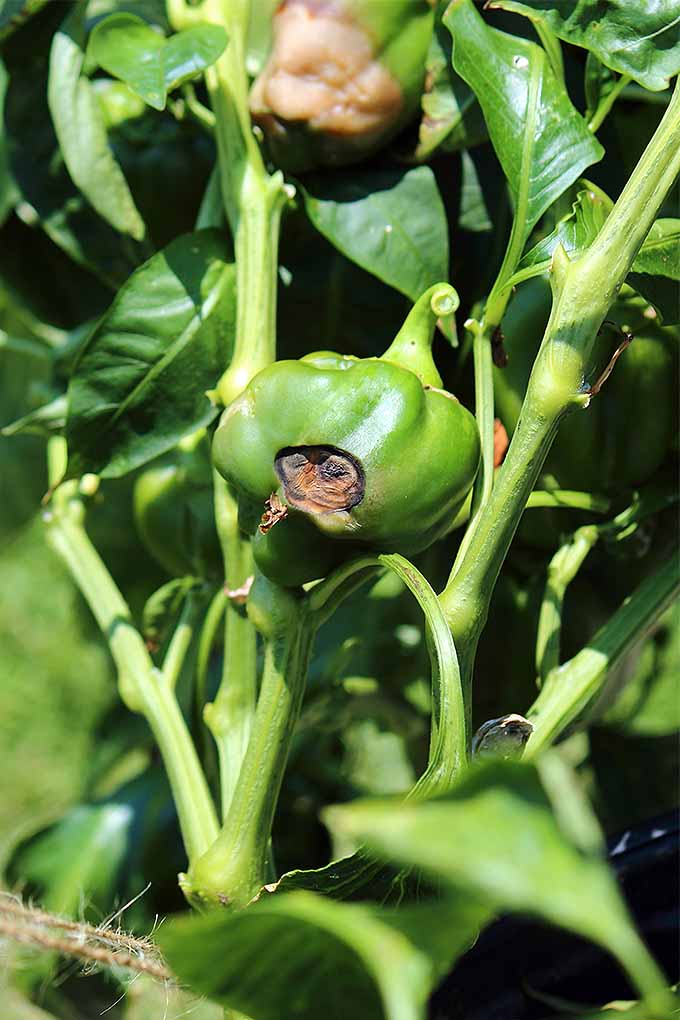
And, since roots are shallow, it's easier to damage them when caring for and weeding your garden. Damaged roots aren't going to be as effective in taking upward needed nutrients.
Also go along an eye out for aphids, spider mites, stink bugs, flea beetles, and cutworms. Spray these critters with a strong stream of water, horticultural oils, or simply mitt pick and squash all who are unwelcome.
The best fashion to mitigate all pest and disease issues is to maintain healthy plants within an optimal environment. Check your garden regularly and be quick to address any concerns. And do your best to invite natural predators into your gardens, such every bit birds, praying mantises, and ladybugs.
Harvesting
Sweet bells are unique, since choosing when to pick them is more often than not up to you.
If you lot love the season of a green pepper, pick a few when they're full-sized with thick flesh but non yet beginning to turn shades of red, xanthous, or orangish (or purple! or dark-brown!). The peppers will sweeten the longer you leave them on the plant, with increased vitamin C content too.

Make a clean cutting with a knife or abrupt scissors when harvesting, being careful not to topple or otherwise disturb the plant. Y'all don't desire to knock off whatsoever fruits that are withal developing, or cause whatsoever damage.
Wipe whatsoever excess dirt away with a clean, dry textile and store in the produce crisper bin of the fridge for upward to 1 week. Wait to wash until you're ready to apply them, since damp produce with go moldy and rot speedily in the fridge.
A Few Recipe Ideas
In add-on to being delicious in a salad, or sliced into strips and served with a big bowl of homemade hummus, homegrown bells add texture and flavor to a variety of tasty dishes.
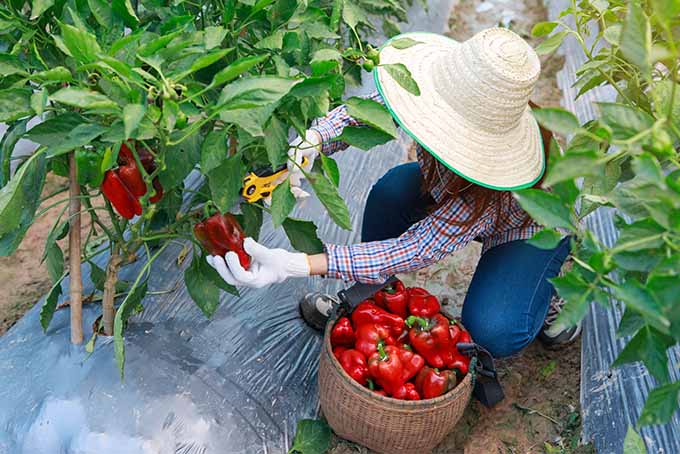
Try this recipe for Spiralized Sweetness Irish potato Noodles with Roasted Ruby Peppers and Sunday Dried Tomatoes from our sister site Foodal, or this homemade Harissa Sauce from our friends at Wanderspice.
Fajitas are a family favorite, and this Vegetable Fajita Sail Pan Dinner from The Domestic Dietitian comes together in minutes. And you're sure to love this Edible bean-Costless Low FODMAP Chili from Erika'southward Gluten-Gratis Kitchen.
For breakfast, serve upwardly a cast iron pan-total of this irresistible South Asian Spiced Shakshuka with Bell Pepper and Spinachfrom Feast in Thyme.
And don't forget, in improver to sharing with the neighbors, a big harvest gives you a chance to show off your habitation preservation chops. Roasted, they tin be stored in oil. Or effort parboiling, peeling, chopping, and freezing in private packages for a quick add together-in to toss into weekend omelets and egg scrambles.
Peppers can also be chopped and dehydrated for utilise in soups, or ground into a flavorful powder that you can add to your spice chiffonier.
Worth the Effort
There's quite a bit of information provided here, and information technology may seem just a bit overwhelming to take on bell peppers as a home gardener. And then, I want to wrap upwardly with a few key points:
- Start seeds early or buy skillful looking seedlings, and make sure to harden them off before transplanting.
- Wait to transplant into the garden until two or more weeks past the last frost engagement, since soil needs to be warm for plants to really take off.
- Mulch and keep water wet consequent, since roots are shallow and susceptible to h2o-related stress.
- Don't fret nearly what you lot can't command – like temperatures that are too hot or too common cold.
Proceed these nuts in mind and you'll be enjoying some tasty sugariness bong peppers before long enough!
Feeling confident plenty to grow bong peppers this year? Let us know what varieties you try and how they come along in your part of the world. And don't forget to check out our full archive of vegetable growing advice hither.
Product images via True Leafage Marketplace. Uncredited photos: Shutterstock. With additional writing and editing by Allison Sidhu. Originally published past Lynne Jaques on December 31st, 2014. Last updated March 8th, 2018.
burnsidetwome1963.blogspot.com
Source: https://gardenerspath.com/plants/vegetables/growing-using-bell-peppers/
0 Response to "How to Puree Red Bell Pepper and Sweet Potato for Baby"
Post a Comment